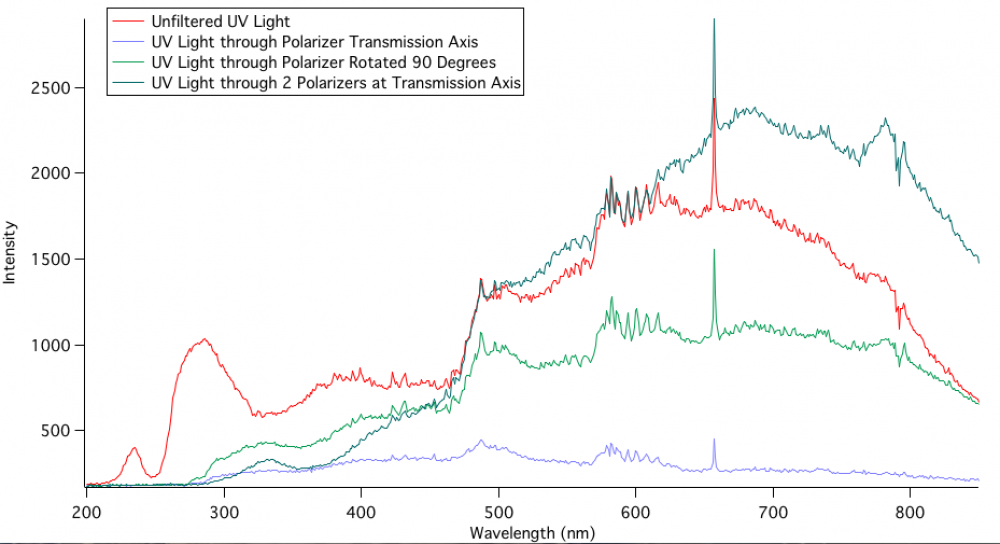The Transmission of UV Light through Polarized Film
This experiment was done to investigate how light transmission is affected by simple polarized film. An OceanOptics DT-Mini-2 Deuterium Tungsten Light Source was directed onto the Ocean Optics Red Tide USB650 UV sensor. Then, a polarized film orientated at its maximum polarization angle was held between the light source and a second spectrum was obtained. Next, the polarizer was rotated 90 degrees to allow maximal transmission through the filter and another spectrum was obtained. Finally, two polarizers each oriented at their maximum polarization angle were held between the light source and the sensor, allowing the final spectrum was obtained. The following graph displays the results. The polarization angle of the polarized films were determined by holding one polarizer up to the screen of the MacBook Pro that was running the Spectra Suite software until the transmission of the light reached a perceived minimum.
The red dataset is the spectrum obtained with the unfiltered lights source. There are some specific characteristics that stick out in this spectrum, particularly the broad peak around 280 nm and the sharp peak around 660 nm. The activity in the wavelength range of less than 400 nanometers was the particular focus of this activity. The presence of a single polarizer oriented at any angle results in an observed decrease in the intensity of the detected light. However, when the polarizer is rotated to maximize its filtration of light emitted from the source, there is a significant decrease in the intensity of light measured across the entire spectrum. There is still a noticeable peak at approximately 660 nm, which I am assuming to be the result of the guide light from the source. There was a significant reduction in the intensity of light detected in the UV range when compared to the spectrum of the unfiltered light source. This is indicative of an effective filtration under this polarizer orientation... Perhaps this is how sunglasses reduce transmission of UV light? When the polarizer was then rotated by 90 degrees to allow for an increase in the transmission of the light source, there is a noticeable increase in the intensity of the light across the spectrum when compared to the previously discussed spectrum. There is also a significant increase in the intensity of light detected in the late UV Range from 290-400. There is a resolution of what appears to a broad peak at 330 nm in this spectrum, which is not found in the unfiltered spectrum. This spectrum also has a peak at the 660 nm wavelength, which means that there is not entire filtration of this wavelength of visible light, despite the filtration of the early UV range. This indicates that the polarizer, when oriented at the correct angle, can decrease the transmission of light in the UV range. This spectrum also shares the high activity shown in the spectrum of the unfiltered light source at the higher wavelengths, including the visible range and the IR range.
When the polarizers were paired together, an interesting spectrum was obtained. We see a decrease in the transmission of light in the UV range when compared to the rotated polarizer spectrum and original spectrum, but we see an increase in the intensity of light beginning around 500 nm and carrying through the rest of the spectrum. This observation contradicts the previous assertion that the presence of any polarizer will result in a decrease in the transmission of light... However, it does not seem possible for the presence of two polarizing films to result in an increase in the intensity of transmitted light in the visible wavelength. This could benefit from additional investigation.
